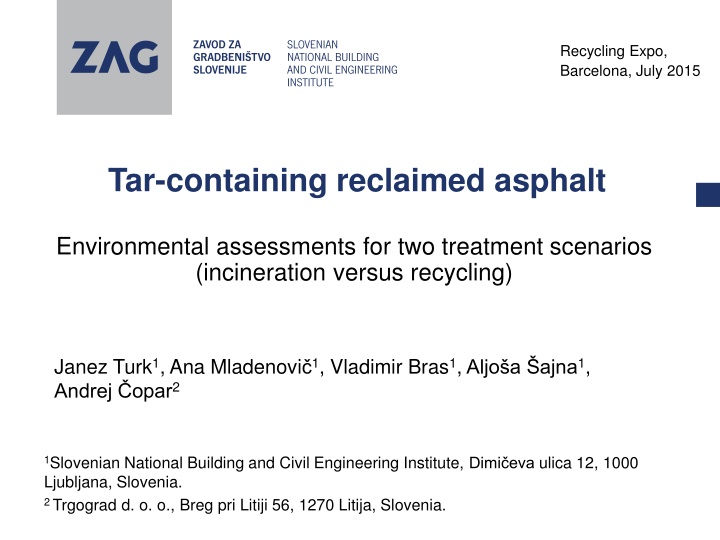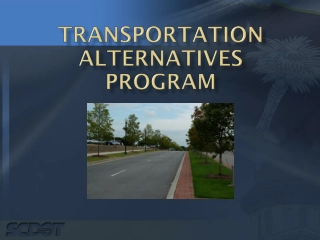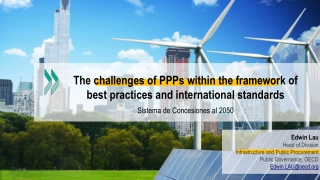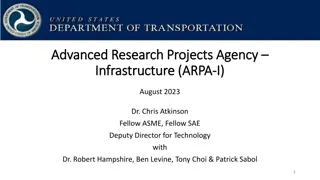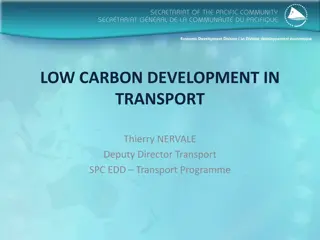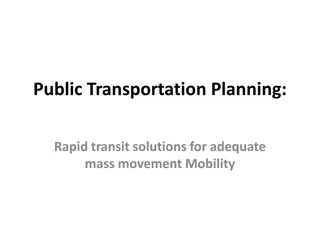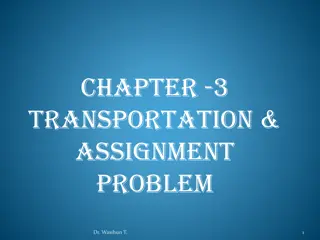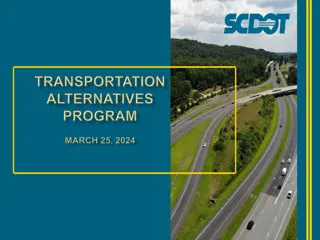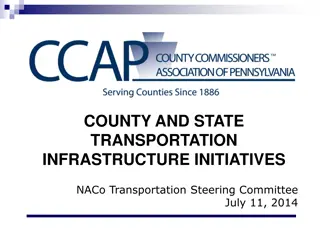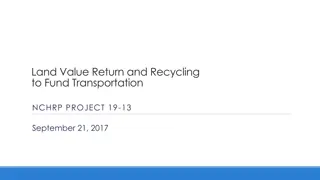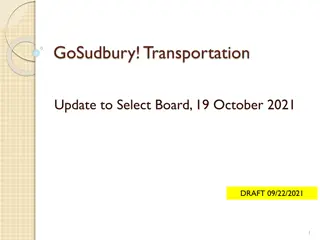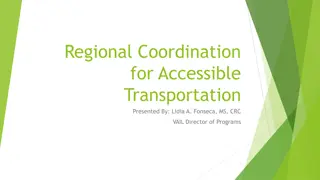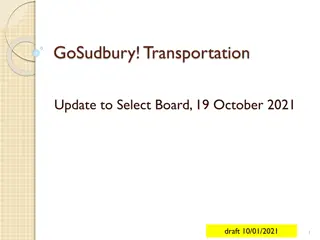Innovative Transportation Technologies for Sustainable Infrastructure
Non-traditional and emerging transportation technologies, like robotic maintenance vehicles and sustainable materials, that can revolutionize infrastructure development and maintenance. Learn how these innovations can enhance safety, efficiency, and sustainability in transportation systems.
Download Presentation

Please find below an Image/Link to download the presentation.
The content on the website is provided AS IS for your information and personal use only. It may not be sold, licensed, or shared on other websites without obtaining consent from the author.If you encounter any issues during the download, it is possible that the publisher has removed the file from their server.
You are allowed to download the files provided on this website for personal or commercial use, subject to the condition that they are used lawfully. All files are the property of their respective owners.
The content on the website is provided AS IS for your information and personal use only. It may not be sold, licensed, or shared on other websites without obtaining consent from the author.
E N D
Presentation Transcript
Recycling Expo, Barcelona, July 2015 Tar-containing reclaimed asphalt Environmental assessments for two treatment scenarios (incineration versus recycling) Janez Turk1, Ana Mladenovi 1, Vladimir Bras1, Aljo a ajna1, Andrej opar2 1Slovenian National Building and Civil Engineering Institute, Dimi eva ulica 12, 1000 Ljubljana, Slovenia. 2 Trgograd d. o. o., Breg pri Litiji 56, 1270 Litija, Slovenia.
1. Introduction Tar, which is a residue of gas and coke production from coal, was quite commonly used in the road construction industry almost until the end of the 20th century, in many countries around the world. Tar, which technical performance is excellent, was used in the past as a binder in asphalt mixes (in asphalt sub-layers as well as in base layers). Source: Internet 2
The abandonment (and in several countries also prohibition) of tar was the result of its toxicity, and was also due to the fact that bitumen production from crude oil became an economically feasible alternative to coal tar. Tar is a hazardous compound: High concentrations of carcinogenic and mutagenic Polycyclic Aromatic Hydrocarbons (PAHs). Tar-containing asphalt (i.e. asphalt which contains more than 0.1 % of coal tar) is classified as hazardous waste (European Waste Catalogue - Code 17 03 01*). 3
It is important to carry out inventory research into quantity of tar used in roads. During road reconstruction and maintenance works, tar- containing asphalt is obtained by crushing, and after this process it becomes exposed to the environment. Possible threats: - spills, - leaks, - contamination of soil and water. 4
1.1 The problem 4500 tons of reclaimed asphalt containing tar (1120 mg/kg in the leachate) were generated during the reconstruction of the runway at Ljubljana Airport (Slovenia) in 2009. This material was temporarily stored under controlled conditions. How to treat with this hazardous waste material? Source: Internet 5
2. Goal Life Cycle Assessment (LCA) analysis was carried out to evaluate quantitatively the environmental benefits of the recycling of reclaimed asphalt in the concrete sector, in comparison with the most easily performed alternative, i.e. at an incineration plant for hazardous materials located outside Slovenia. 6
2.2 Two scenarios First scenario: the tar-containing reclaimed asphalt is used for the production of lean concrete. Reclaimed asphalt is treated as recycled aggregate to replace 40 wt. % of the natural aggregates in the concrete mix. Source: Internet 7
The mix proportions for conventional lean concrete and recycled lean concrete: Constituent material Unit Conventional concrete Concrete with 40 % of recycled materials kg per m3 Cement (CEM II 42.5) 260 260 kg per m3 Aggregate - dolomite 0/4 mm 1156 915 - dolomite 4/8 mm 210 / - dolomite 8/16 mm 737 305 - reclaimed asphalt 0/16 mm / 729 litres per m3 Water 160 155 kg per m3 Plasticizer 1.2 1.2 8
Second scenario: tar-containing reclaimed asphalt is simply considered as a type of hazardous waste. In this case it would be incinerated at an incineration plant. Source: Internet The functional unit is treatment with 1000 kg of reclaimed asphalt. 9
System boundaries of LCA Asphalt layer with tar as a binder Milling Reclaimedasphalt containingtar Temporarystorage Incinerationscenario Recyclingscenario Transport Transport Mixingplant Hazardous waste incineration plant Leanconcrete
2.2.1 The recycling scenario The reclaimed asphalt is treated as a proper aggregate (no additional crushing/screening is needed). The transport of the reclaimed asphalt from the temporary storage area to the mixing plant is taken into account (40 km). Source: Internet Utilization of recycled aggregate the need for natural aggregate is reduced 11
2.2.2 The incineration scenario Truck transport from the temporary storage area to the hazardous waste incineration plant (a one way distance of 1050 km). Incineration of the hazardous waste at rotary kiln incineration plant (900-1600 C). Source: CURRENTA 12
Operation of the plant: A supply of main energy resources (fuel oil, steam, electricity). Use of auxiliary materials for flue gas cleaning. The products of the incineration (i.e. the residual materials) are transported to a landfill area for residual material. Waste water leaving the incineration plant is treated in a treatment plant and discharged to the surface water drainage. Source: Doka G., 2007 13
Heat recovery in the steam boiler: Wastes with high calorific values are able to produce their own process energy during incineration. Amount of complementary fuel input is reduced in such a case. This means that the environmental burdens related to the production of auxiliary fuel are partly reduced. However, the calorific value of reclaimed asphalt is low the reclaimed asphalt produces low amount of process energy. 14
3. Results of LCA analyis - Recycling scenario 15
- Incineration scenario SUM: 543 kg of carbon dioxide equivalent emissions 16
- Incineration scenario SUM: around 3.5 kg of Sb equivalent emissions 18
- Incineration scenario SUM: around 1 kg of sulphur dioxide equivalent emissions 20
Relative comparison of two scenarios 100 80 60 Percentage INCINERATION (%) RECYCLING (%) 40 20 0 GWP AP ADP Gross Energy -20 21
4. Conclusions The incineration scenario exhibits high effects on environmental indicators. A lot of energy has to be used at the incineration plant in order to maintain high combustion temperatures. The net generation of energy during the incineration of low calorific reclaimed asphalt is low. Emissions associated with transport are significant, taking into account long delivery distance of the reclaimed asphalt from source to the incineration plant. 22
The recycling scenario was found to have low environmetal impact: Impacts on Global Warming and Abiotic Depletion are significantly low. In case of impact on Acidification, even some benefits were revealed. Environmental footprint of recycling scenario greatly depends on delivery distance of tar-containing asphalt from source to asphalt plant (delivery distance was relatively short - 40 km in this case study). However, certain limitations about the application of such recycled lean concrete need to be strictly taken into account (not exposed to groundwater). 23
Hvala! Thank you for attention! For more information see: Turk, J., Mladenovi , A., Knez F., Bras, V., ajna, A., opar, A., Slanc, K., 2014. Tar-containing reclaimed asphalt Environmental and cost assessments for two treatment scenarios. Journal of Cleaner Production 81, 201-210. 24
